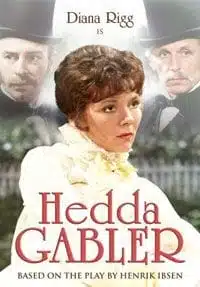
“A great, largely misused play.” — John Osborne
The enigmatic character of Hedda Gabler is often referred to as the “female Hamlet”. Yet it’s not a case of indecision that marks Henrik Ibsen’s heroine, but rather a complex series of motives that may in fact be merely spontaneous and even mysterious to the woman herself. It is this enigmatic quality that once inspired patriarchal criticisms of dramatic implausibility, as if a woman could not behave in such a clearly “irrational” way. The character was labeled a “demoness” for the same reason, her reckless, supposedly inexplicable behavior causing the death of a former lover through manipulative will.
But this is very much the crux of the play’s attraction. With Hedda Gabler, Ibsen created a character that at once invited sympathy as well as revulsion. Hedda is never made to appear “nice” in any way, and in this fine Yorkshire Television production from 1980, Diana Rigg plays the title role without remorse. Her Hedda suffers no fools and appears ready to strike like a coiled snake.
It has always been a difficult role, since Hedda can appear to be villainous or worse yet, sphinx-like. This adaptation by John Osbourne (Look Back in Anger) attempts to present her fairly; not only sympathetically but also critically. It still seems odd to me that Osbourne has referred to Hedda as “a bourgeois snob and a walking waste of human personality. She is indolently evil and lives off her own fantasies, absorbing from people better than herself.” This is not the way Rigg plays the role and clearly not the effect achieved in the adaptation. Osbourne seems to want us to hate her, but perhaps Ibsen won out here.
When we first meet her, “Hedda Gabler” is already a memory. She has just returned from what seems to have been a miserable honeymoon as “Hedda Tesman”, the wife of the stiff academic, George Tesman (Dennis Lill). She appears bored, frustrated, and full of intellectual disgust with her dull academic husband. Initially, her behavior seems unreasonable and spiteful. In fact, she treats George’s aunt Julianne (Kathleen Byron) with open contempt, a direct social shock to both Julianne and George who can do nothing but humor the social transgression in response.
But it soon becomes apparent just what Hedda’s future will be all about. She can clearly see her rounds of dull social calls, visits to sickly relatives, and dinner parties full of pompous talk. She is clearly unable to accept her place within the shackles of marriage and the delicate rules of social life which confine her intellect and wit to the smallest space possible.
With nothing more than her wit to claw back at the world, Hedda uses it with great relish, sparing nothing and no one, it seems. Because we are not privy to any direct monologues or a voiceover narration, her motives remain unknown. We are merely able to observe as she seems to lie, provoke, and manipulate those around her as the situation presents itself. Like the crafty protagonists of Dashiell Hammett’s detective stories, Hedda is clearly trying to play an angle, but only through opportunity.
Opportunity comes knocking not once but twice in the same day. The wife of an old friend, Mrs. Elvsted (Elizabeth Bell), arrives to ask the Tesmans whether they know the whereabouts of their mutual acquaintance and Tesman’s academic rival, Eilert Lovborg (Phillip Bond). Lovborg is an alcoholic who has wasted much of his intellectual talents until now. With the help of Mrs. Elvsted whose children he was tutoring, Lovborg has been able to sober up and complete a manuscript which everyone seems to believe is a conceptual masterpiece.
Unknown to all, Lovborg is Hedda’s former lover and more than that, her only intellectual equal. When Lovborg himself calls on the Tesmans and seems to be merely a shell of the man Hedda once knew, it seems that she makes the immediate decision to break him from Mrs. Elvsted’s influence and destroy him. But what is that she really wants? Destruction of her former lover’s free life? An honorable way out for his soon to be academic imprisonment? Or is she just pulling the wings off a fly, without care or motive? The play remains enigmatic no matter how Osborne believes it should be used.
A veteran of both the theater and television, Diana Rigg is able to convey the character not only through voice and movement, but also brilliantly in close-ups where a simple glance or smirk allows us a peek into Hedda’s thoughts. We can clearly see when Hedda seems to be excited, afraid, or silently crafting her next move.
As a British television production from ’80, Hedda Gabler suffers from much of the same flat video lighting and tinny sound recording that was common at the time, and it does not improve with its release on DVD. Cunliffe does a decent job covering the play in a standard three camera set up, but sacrifices movement for simple crosscutting. He does make very good use of close-ups, however, and is able to translate the play to televisual medium competently enough.
But it’s the costume design that’s most effective. Rigg is dressed in a series of outfits that seem to be cutting off her very breathing, with collars that hold tight around the neck like flowery chains. The effect is appropriately stifling.
